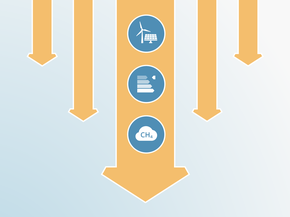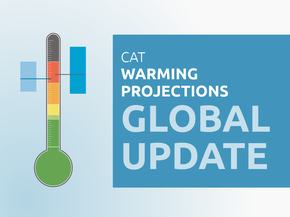Assumptions
Historical emissions
Historical emissions in all sectors excluding LULUCF for the period 1990–2020 as well as LULUCF emissions for 1990–2020 were taken from the national GHG inventory submitted as part of Argentina’s Fifth BUR submitted in December 2023 to the UNFCCC (Government of Argentina, 2023a). These were extended until 2022 using growth rates from PRIMAP v2.5 Final (Gütschow & Pflüger, 2023).
NDC and other targets
NDC absolute emissions levels including LULUCF are provided directly in the NDC for the unconditional target (Government of Argentina, 2021). To obtain the NDC emissions level excluding LULUCF, the CAT uses a Business-As-Usual scenario for the LULUCF sector developed by UNICEN (Keesler & Blanco, 2024). This scenario shows that under current policies, LULUCF emissions in Argentina will steadily decrease, reaching 15.2 MtCO2e by 2030.
We also recalculate the target, that is originally communicated as an absolute number calculated using SAR GWP, to AR4 GWP. To do so, we calculate the difference in emissions between the last inventory year (2020) and the target year (2030) in SAR and apply the growth rate to the last historical value (from 2022) in AR4.
Current policy projections
The CAT uses the projections developed by Gabriel Blanco and Daniela Keesler (UNICEN), in the report “Transición energética en la Argentina: Construyendo alternativas”, and “Escenarios 2050 para la Argentina: sector agrícola, ganadero, forestal y otros usos de la tierra” (Blanco & Keesler, 2022; Keesler & Blanco, 2024) to develop our current policy projections. These studies provide projections for all sectors based on current sectoral plans and actions in place, including the exploitation of non-conventional fossil fuels as of 2022.
The UNICEN business-as-usual (BAU) scenario for the power sector has the following assumptions:
- Accounts for the penetration of renewable energy in the power sector following the current trend
- Adjusts the emissions curve of the power sector to capture the current development of nuclear energy
- Accounts for barriers in the implementation of energy efficiency measures presented in the sectoral plans (buildings, industry, and transport)
- Takes into account the significant development plan for the exploration and exploitation of fossil fuels (fracking and off-shore oil and gas production)
- The document does not mention the carbon tax
We apply the growth rates from the UNICEN BAU scenario for the energy, industry, and waste sectors to the 2022 historical data points for those sectors.
The agriculture sector projections have the following assumptions:
Livestock:
- An increase in the number of heads of cattle for beef, reaching almost 62 million heads by 2050, representing a 24% increase compared to the current stock, driven by the combined increase in domestic consumption and exports.
- A 10% increase in the efficiency of beef production by 2050 compared to the current 216 kg/head slaughtered.
- A 28% growth in beef exports compared to 2020 values, following the trend of international beef trade projected by OECD/FAO (2021). Although global per capita consumption is expected to decline by 5% by 2030, population growth will result in a 0.7% increase in global beef demand in the same period (OECD, 2021) .
Agriculture:
- A 14% increase in the use of synthetic nitrogen fertilizers by 2050 compared to the current 16.6 kg fertilizer/ton of grain, considering usage trends from the last 30 years (1990-2020).
- No change in the management of harvest residues compared to current practices.
- A 90% reduction in the burning of forests and grasslands compared to the 1,000,000 ha that are currently burned.
Net-zero target and other long-term targets
Argentina committed to a net zero GHG emissions by 2050. However, its long-term strategy does not include additional information on how Argentina plans to reach its target, particularly on sectoral pathways towards net zero and the expected contribution of sinks from the LULUCF sector.
The CAT uses a simplified method to estimate residual emissions under Argentina’s net zero target in 2050. The calculation is based on LULUCF projections created by UNICEN for Argentina’s AFOLU sector in their net zero AFOLU scenario (Keesler & Blanco, 2024). This scenario assumes net LULUCF emissions of -71 MtCO2e in 2050. For the simplified net zero pathway for Argentina’s economy-wide emissions, the CAT assumes residual emissions to match the LULUCF sinks of -71 MtCO2e in 2030 and assuming a linear decrease from the 2030 current policy pathways (i.e., 405 MtCO2e in 2030) to 71 MtCO2e in 2050, reaching economy-wide net zero GHG emissions.
Global Warming Potentials values
The CAT uses Global Warming Potential (GWP) values from the IPCC's Fourth Assessment Report (AR4) for all its figures and time series. Assessments completed prior to December 2018 (COP24) used GWP values from the Second Assessment Report (SAR).
Further analysis
Latest publications
Stay informed
Subscribe to our newsletter




